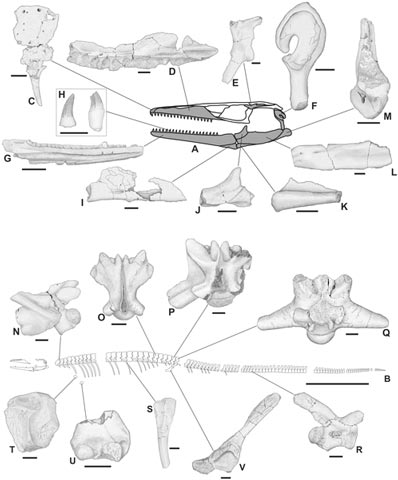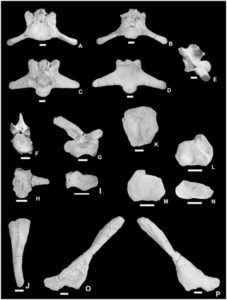Freshwater Mosasaur from a Hungarian Bauxite Mine
Pannoniasaurus inexpectatus – The Unexpected Mosasaur
A joint team of Hungarian and Canadian scientists have unearthed a new species of mosasaur, one that as far as the known fossil record goes, was unique amongst the Mosasauridae – it lived in freshwater. It seems that just like some species of extant cetacean (whales and dolphins), one group of mosasaurs adapted to living in a freshwater environment. There are river dolphins that live in the Amazon and other riverine habitats such as, until recently, the Yangtze river (Yangtze river dolphin believed to be extinct). Now scientists have the fossilised remains of several freshwater mosasaurs to study, a number of individuals, all of which have been assigned to a new species – Pannoniasaurus inexpectatus.
Freshwater Mosasaur
Mosasaurs are members of the Order Squamata (lizards and snakes), they evolved from terrestrial reptiles but they adapted to marine environments and rapidly diversified with many different genera and something approaching eighty different species being recognised. Mosasaurs were typically streamlined, with long, narrow jaws, four paddles and possibly a fish like tail, (new evidence suggests that some mosasaurs had tail fins like those found on extinct ichthyosaurs and extant dolphins). As vertebrates; their backbones became specially adapted to undulate in an up and down motion to aid propulsion through water. Some of these marine lizards evolved into giant forms such as Tylosaurus and Hainosaurus which could have been as much as fifteen metres in length.
It seems that these reptiles, whose closest living relatives today are thought to be the monitor lizards (Varanus), evolved around ninety million years ago and spread throughout the world’s oceans before dying out approximately around 25 million years later.
Pannoniasaurus inexpectatus
The holotype fossil material, plus over one hundred Pannoniasaurus fossils so far collected from the location come from alluvial (floodplain and channel) deposits which form a section of the Csehbánya Formation of Cretaceous aged strata. The fossils which include juveniles and bones from specimens which may have exceeded six metres in length come from various exposures at the Iharkút open-pit bauxite mine in Hungary.
An Illustration of the Skeleton of P. inexpectatus
Picture credit: PLoS One/Makádi et al
It is thought that this river mosasaur had a similar body shape to other mosasaurs as well as long, narrow, crocodile-like jaws. Palaeontologists believe that this genus represents a basal member of the Mosasauridae, it may have retained feet with clawed toes that were capable of moving the animal about on land. However, no lower limb bones have been found to date. The flattened skull, may have been a useful adaptation for water-level hunting and the ambushing of terrestrial animals such as small dinosaurs that came close to water’s edge.
The research team speculate that more robust limbs with claws may have been retained by these mosasaurs as they could have used their feet and claws to clamber over the bottom of the river just as extant crocodiles do today. At six metres in length [about the size of a modern-day Nile crocodile (Crocodylus niloticus)], these mosasaurs were the largest predators within this Late Cretaceous river environment.
Virtually all the other known mosasaur fossils have been found in strata which was laid down in marine environments. Previously, the only exception to this was some fragmentary fossils of the marine, nektonic mosasaur known as Plioplatecarpus which was discovered in non-marine rocks in Western Canada (Alberta). The Plioplatecarpus remains include teeth and a partial vertebra collected from the a mudstone unit in the middle of the Lethbridge Coal Zone.
These bones could have been re-deposited there after a tsunami or other flood event, or perhaps they represent individuals who went upstream from estuaries in a similar way to modern Bull sharks.
The genus name for this new mosasaur comes from the ancient Roman province of “Pannonia”, which contained this part of Hungary, the specific name “inexpectatus” means unexpected in Latin, a reference to the surprising occurrence of mosasaur fossils in a non-marine palaeoenvironment.
A More Typical Mosasaur (Marine Reptile Museum Exhibit)
Picture credit: PLoS One/Makádi et al
The size of the individual fossil bones collected so far indicate that these bones represent a number of differently-sized creatures. The smallest seem to have been less than a metre in length, the average overall length would have been around three to four metres. This suggests that many animals of various sizes and ages were present together living in these prehistoric rivers.
Everything Dinosaur supplies a wide variety of marine reptiles including replicas of mosasaurs: Papo Marine Reptiles, Dinosaurs and Prehistoric Animal Figures.
In the paper, published in the on line scientific journal PLoS One (Public Library of Science), the research team state that their studies suggest no fossilisation bias and that the Pannoniasaurus fossils probably represent the population quite accurately. This suggests that a population of these reptiles was living in the river system, it is unlikely that the fossils ended up in non-marine strata as mosasaurs migrated upstream to take advantage of seasonal food opportunities or in order to give birth in freshwater rather than in the open sea.
This part of Europe during the Late Cretaceous consisted of a series of tropical islands, other fossils found in the Csehbánya Formation include fish, amphibians, crocodiles, turtles, several dinosaur genera, pterosaurs and birds.
The scientific paper: “The First Freshwater Mosasauroid (Upper Cretaceous, Hungary) and a New Clade of Basal Mosasauroids” by László Makádi, Michael W. Caldwell and Attila Ősi published in PLoS One.



